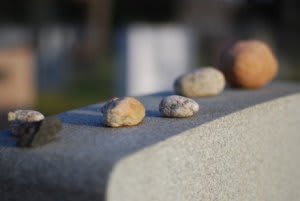BURIAL
In the final chapters of Bereshit we learn of the deaths of Yaakov and of Yosef, and of their insistence on being buried in Eretz Yisrael. (Bereshit 49:29 – 50:26.) This continues the special attention this book pays to burial and burial places: an entire chapter (23) is devoted to the purchase of the Makhpela Cave as a burial place, and the Torah discusses the burial there of Avraham (Bereshit 25:9-10) and of Yitzchak (35:29).
Burial of the dead is a paramount value in Jewish law and tradition. Even a blasphemer who is publicly disgraced by hanging must be buried immediately afterwards so as to limit his shame (Devarim 21:23), and the gemara infers from this that burial is a mitzva in general. (Sanhedrin 46b.) And one of the greatest mitzvot of all is to bury a “met mitzva”, a fellow Jew who has no relatives to take care of his burial; and even the Kohen Gadol, who is normally forbidden to take part even in the burial of his own parents, is commanded to occupy himself with such a burial. (Vayikra 21:11 and Rashi there.)
DIGNITY AND ATONEMENT
The gemara cited mentions two main purposes of burial. One reason is shame, and the other atonement. The Rishonim rule that both reasons apply. The reason of shame implies that even if a person wishes to waive this particular atonement and asks not to be buried, his wishes are not honored after his death. It also implies that even a person who requires no atonement must be buried.
The consideration of shame is explicit in the Torah, in the verse we just mentioned: “For a hanged person is a reproach before G-d”. (Devarim 21:23.) It is not just the deceased himself who is disgraced when denied burial; it is also the family (Rashi on Sanhedrin 46b). Rashi (on the Torah) mentions that this is even an indignity towards HaShem; since the human body is created in the image of G-d we must relate to it with respect.
Another way of looking at this reproach is that it stems from the degradation the body suffers from being reduced from the abode of the soul during the person’s life to a mere cadaver. Our consciousness of this terrible degradation is part of the jarring experience of seeing a dead person; conversely, becoming inured to seeing corpses can weaken our sense of how tragic the loss of spirit is.
The connection of burial to atonement is hinted at already in the story of creation. When man is first created, the Torah mentions that he was not made of some other-worldly material but rather “dust from the earth”. (Bereshit 2:7). After death is decreed on mankind subsequent to sin, the Torah adds that “dust you are, and to dust you return”. (Bereshit 3:19.)
Rashi on the earlier verse gives two explanations of the significance of man’s creation from the dust of the earth. One is that man’s body can be accepted by the earth after death. This is related to the consideration of shame. If the body were not absorbed by the earth, it would be in evidence forever – like a met mitzva cast in disgrace.
Rashi’s second explanation is that man was specifically created from the earth of the place of the Mikdash, where there was an altar filled with earth which provides atonement. In this way man’s very creation carries with it the seeds of his atonement. What is the atonement of burial, and how is it related to that of the altar?
Rashi on Sanhedrin explains that there is atonement in the very degradation of being lowered into the earth. (The Rishonim discuss the paradox this creates in light of the Gemara’s previous statement that it is the lack of burial which is degrading.) This does indeed have a parallel in the atonement of the altar, which according to the Ramban stems from the fact that the slaughter of the sacrifice is a kind of humbling symbolic slaughter of the sinner.
But this is not the whole story. The whole point of the sacrifice is that after the animal is slaughtered, it is then placed on the altar where it is elevated as a sacrifice to HaShem! This parallels the process of repentance. Through the presence of the soul, the material body is elevated. But sin dims the light of the spirit, which is restored through repentance. The sacrifice reminds us on the one hand that through sin we lower ourselves to the level of animals, or to the level of inanimate matter. But the atonement stems from offering the sacrifice on the altar, reminding us that the potential for holiness is still present.
The same applies to burial. On the one hand, the humbling process of burial reminds us that after all is said and done our bodies are mere dust of the earth. But there is atonement in this humiliation when we recall that Adam was also created from the dust of the earth, but that even so HaShem breathed into him a holy living spirit – as mentioned in the very same verse in Bereshit. (2:7, see the Midrashim on this verse.)
Rabbi Asher Meir is the author of the book Meaning in Mitzvot, distributed by Feldheim. The book provides insights into the inner meaning of our daily practices, following the order of the 221 chapters of the Kitzur Shulchan Arukh.
The words of this author reflect his/her own opinions and do not necessarily represent the official position of the Orthodox Union.
